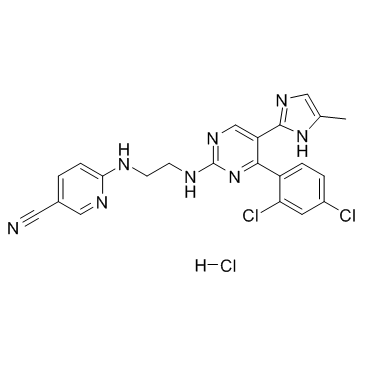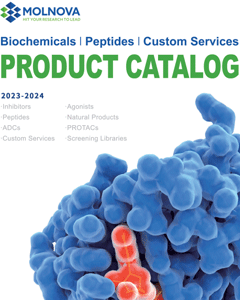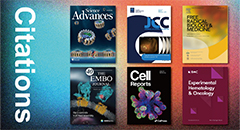
CHIR-99021 monohydrochloride
CAS No. 1797989-42-4
CHIR-99021 monohydrochloride( CT99021 monohydrochloride | CHIR99021 monohydrochloride )
Catalog No. M12717 CAS No. 1797989-42-4
A potent, specific GSK-3 inhibitor with IC50 of 5 nM and 10 nM for GSK3β and GSK3α, respectively.
Purity : >98% (HPLC)
 COA
COA
 Datasheet
Datasheet
 HNMR
HNMR
 HPLC
HPLC
 MSDS
MSDS
 Handing Instructions
Handing Instructions
| Size | Price / USD | Stock | Quantity |
| 2MG | 40 | In Stock |


|
| 5MG | 63 | In Stock |


|
| 10MG | 87 | In Stock |


|
| 25MG | 149 | In Stock |


|
| 50MG | 228 | In Stock |


|
| 100MG | 441 | In Stock |


|
| 200MG | 640 | In Stock |


|
| 500MG | 972 | In Stock |


|
| 1G | Get Quote | In Stock |


|
Biological Information
-
Product NameCHIR-99021 monohydrochloride
-
NoteResearch use only, not for human use.
-
Brief DescriptionA potent, specific GSK-3 inhibitor with IC50 of 5 nM and 10 nM for GSK3β and GSK3α, respectively.
-
DescriptionA potent, specific GSK-3 inhibitor with IC50 of 5 nM and 10 nM for GSK3β and GSK3α, respectively; mimics Wnt signaling in preadipocytes, stabilizes free cytosolic beta-catenin and inhibits adipogenesis by blocking induction of C/EBPα and PPARγ; potentiates insulin activation of glucose transport and utilization in vitro and in vivo; also widely used for stem cell differentiation and naive stem cell generation.(In Vitro):Laduviglusib monohydrochloride inhibits human GSK-3β with Ki values of 9.8 nM. Laduviglusib monohydrochloride is a small organic molecule that inhibits GSK3α and GSK3β by competing for their ATP-binding sites. In vitro kinase assays reveal that Laduviglusib monohydrochloride specifically inhibits GSK3β (IC50=~5 nM) and GSK3α (IC50=~10 nM), with little effect on other kinases. In the presence of Laduviglusib monohydrochloride the viability of the ES-D3 cells is reduced by 24.7% at 2.5 μM, 56.3% at 5 μM, 61.9% at 7.5 μM and 69.2% at 10 μM Laduviglusib monohydrochloride with an IC50 of 4.9 μM. (In Vivo):In ZDF rats, a single oral dose of Laduviglusib (16 mg/kg or 48 mg/kg) monohydrochloride rapidly lowers plasma glucose, with a maximal reduction of nearly 150 mg/dl 3-4 h after administration. Laduviglusib (2 mg/kg) monohydrochloride given once, 4 h before irradiation, significantly improves survival after 14.5 Gy abdominal irradiation (ABI). Laduviglusib monohydrochloride treatment significantly blocks crypt apoptosis and accumulation of p-H2AX+ cells, and improves crypt regeneration and villus height. Laduviglusib monohydrochloride treatment increases Lgr5+ cell survival by blocking apoptosis, and effectively prevents the reduction of Olfm4, Lgr5 and CD44 as early as 4 h.
-
In Vitro——
-
In Vivo——
-
SynonymsCT99021 monohydrochloride | CHIR99021 monohydrochloride
-
PathwayPI3K/Akt/mTOR signaling
-
TargetGSK-3
-
RecptorGSK-3
-
Research AreaCancer
-
Indication——
Chemical Information
-
CAS Number1797989-42-4
-
Formula Weight501.7989
-
Molecular FormulaC22H19Cl3N8
-
Purity>98% (HPLC)
-
Solubility10 mM in DMSO
-
SMILESCC1=CN=C(N1)C2=CN=C(N=C2C3=C(C=C(C=C3)Cl)Cl)NCCNC4=NC=C(C=C4)C#N.Cl
-
Chemical Name3-Pyridinecarbonitrile, 6-[[2-[[4-(2,4-dichlorophenyl)-5-(5-methyl-1H-imidazol-2-yl)-2-pyrimidinyl]amino]ethyl]amino]-, hydrochloride (1:1)
Shipping & Storage Information
-
Storage(-20℃)
-
ShippingWith Ice Pack
-
Stability≥ 2 years
Reference
1. Ying QL, et al. Nature. 2008 May 22;453(7194):519-23.
2. Ring DB, et al. Diabetes. 2003 Mar;52(3):588-95.
3. Bennett CN, et al. J Biol Chem. 2002 Aug 23;277(34):30998-1004.
4. Li W, et al. Stem Cells. 2009 Dec;27(12):2992-3000.
molnova catalog



related products
-
GSK-3β inhibitor 14
GSK-3β inhibitor 14 (1,5-Benzothiazepin-4(5H)-one, 2,3-dihydro-2-methyl-5-(phenylmethyl)-) is a weak GSK-3β inhibitor, IC50﹥ 100μM.
-
LY2090314
LY2090314 is a potent GSK-3 inhibitor for GSK-3α/β with IC50 of 1.5 nM/0.9 nM.
-
Tideglusib
Tideglusib is an irreversible, non ATP-competitive GSK-3β inhibitor with IC50 of 60 nM in a cell-free assay.



 Cart
Cart
 sales@molnova.com
sales@molnova.com


